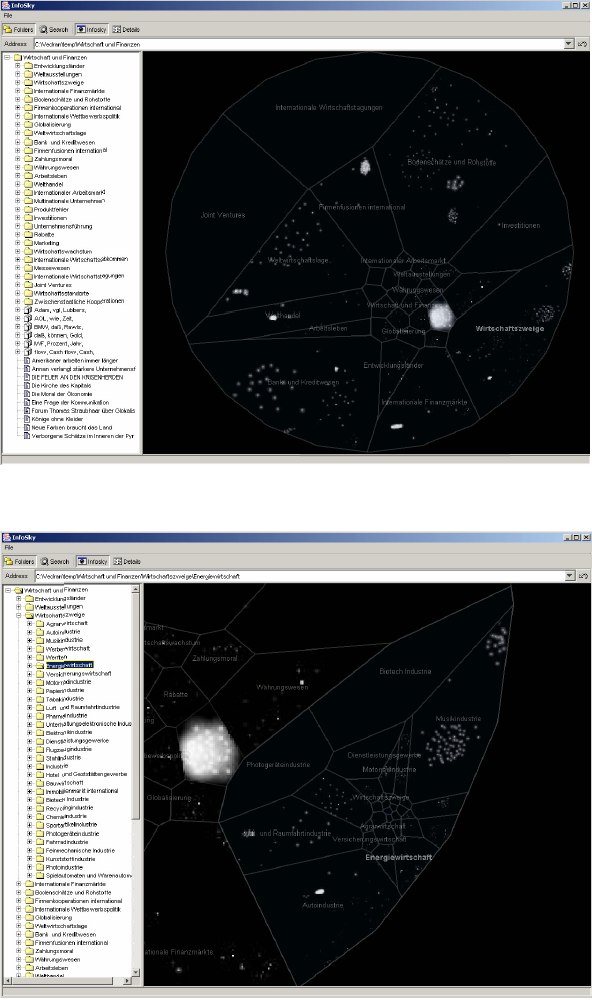InfoSky: Difference between revisions
Jump to navigation
Jump to search
Gruppe8 SS07 (talk | contribs) |
Gruppe8 SS07 (talk | contribs) |
||
| Line 28: | Line 28: | ||
{{Quotation|Focus plus context: Integrate both a global and a local view of the information space into one seamless visualisation. | [Granitzer et al., 2004]}} | {{Quotation|Focus plus context: Integrate both a global and a local view of the information space into one seamless visualisation. | [Granitzer et al., 2004]}} | ||
<br/> | <br/> | ||
{{Quotation|Stability: Use a stable metaphor which promotes visual recall | {{Quotation|Stability: Use a stable metaphor which promotes visual recall and recognition of features. The visualisation should remain largely unchanged at a global level even if changes occur to the underlying document repository on a local level. | [Granitzer et al., 2004]}} | ||
and recognition of features. The visualisation should remain largely unchanged at a global level even if changes occur to the underlying document repository on a local level. | [Granitzer et al., 2004]}} | |||
<br/> | <br/> | ||
{{Quotation|Unified frame of reference: Support a single, consistent view | {{Quotation|Unified frame of reference: Support a single, consistent view of the document space for all users, regardless of the access rights of each individual user, thus providing a common frame of reference for all parties. | [Granitzer et al., 2004]}} | ||
of the document space for all users, regardless of the access rights of each individual user, thus providing a common frame of reference for all parties. | [Granitzer et al., 2004]}} | |||
<br/> | <br/> | ||
{{Quotation|Exploration: Provide simple, intuitive facilities to browse and search the repository. The visualisation tool should allow the visualisation to display a maximum number of document properties and relationships without any need for user | {{Quotation|Exploration: Provide simple, intuitive facilities to browse and search the repository. The visualisation tool should allow the visualisation to display a maximum number of document properties and relationships without any need for user | ||
Revision as of 18:47, 11 April 2007
Authors
- Michael Granitzer
- Wolfgang Kienreich
- Keith Andrews
- Vedran Sabol
- Werner Klieber
Short description
The InfoSky visual explorer is a system enabling users to interactively explore large, hierarchically structured document collections. Similar to a real-world telescope, InfoSky employs a planar graphical representation with variable magnification. Documents of similar content are placed close to each other and displayed as stars, while collections of documents at a particular level in the hierarchy are visualised as bounding polygons. Usability testing of an early prototype implementation of InfoSky revealed several design issues which prevented users from fully exploiting the power of the visual metaphor. Evaluation results have been incorporated into an advanced prototype, and another usability test has been conducted. A comparison of test results demonstrates enhanced system performance and points out promising directions for further work.
[Michael Granitzer et al., Evaluating a System for Interactive Exploration of large, Hierarchically Structured Document Repositorieset, IEEE Symposium on Information Visualization 2004]
Suitable Datatypes
Suitable Datatypes for this information visualization technique are hierarchical information structures. The goal of InfoSky is to reduce the complexity of large amounts of text-data (for examples collections of newspaper articles) by presenting it through the metapher of a telescope view in a hierarchically structured form. Text-data can be either Word documents, PDF or HTML files.
Figures
Pictures of the InfoSky Browser 2002

Reengineered InfoSky Browser 2004

Important Citations
Main challenges of Infosky:
Hierarchy plus similarity: Represent both the hierarchical organisation of documents and inter-document similarity within a single, consistent visualisation.
[Granitzer et al., 2004]
Focus plus context: Integrate both a global and a local view of the information space into one seamless visualisation.
[Granitzer et al., 2004]
Stability: Use a stable metaphor which promotes visual recall and recognition of features. The visualisation should remain largely unchanged at a global level even if changes occur to the underlying document repository on a local level.
[Granitzer et al., 2004]
Unified frame of reference: Support a single, consistent view of the document space for all users, regardless of the access rights of each individual user, thus providing a common frame of reference for all parties.
[Granitzer et al., 2004]
Exploration: Provide simple, intuitive facilities to browse and search the repository. The visualisation tool should allow the visualisation to display a maximum number of document properties and relationships without any need for user
interaction. It should thus offer a means of locating documents without specifying a query, by simply browsing the information space and displaying information within its
context. [Granitzer et al., 2004]
Scalability: Visualise very large (hundreds of thousands, if not millions of entities), hierarchically structured document repositories.
[Granitzer et al., 2004]
Evaluation
References
- [Robertson et al., 1991] George Robertson, Jock D. Mackinlay, Stuart Card. Cone Trees: Animated 3D Visualizations of Hierarchical Information. In Proceedings of the ACM CHI 91 Human Factors in Computing Systems Conference, pages 189-- 194, April 28 - June 5, 1991, New Orleans, Louisiana, June 1991. Association for Computing Machinery
Evaluation References
- [Cockburn and McKenzie, 2000] Andrew Cockburn and Bruce McKenzie. An Evaluation of Cone Trees. In People and Computers XIV: British Computer Society Conference on Human Computer Interaction 2000, p425--436. Springer-Verlag.
- [Hearst and Karadi, 1997] Marti A. Hearst and Chandu Karadi. Cat-a-Cone: An Interactive Interface for Specifying Searches and Viewing Retrieval Results using a Large Category Hierarchy. In Proceedings of the Twentieth Annual International ACM SIGIR Conference, pages 246-- 255, Philadelphia, PA, July 1997
- [Hemmje, 1994] Matthias Hemmje, LyberWorld - A 3D Graphical User Interface for Fulltext Retrieval. Created at: May 7-11 1995. Retrieved at: April 13, 2006. http://delivery.acm.org/...